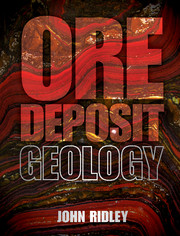Book contents
- Frontmatter
- Contents
- List of boxes
- Preface
- Acknowledgements
- 1 What is an ore deposit?
- 2 Magmatic ore deposits
- 3 Hydrothermal ore deposits I: magmatic and orogenic environments
- 4 Hydrothermal ore deposits II: sedimentary environments
- 5 Ore deposits formed in sedimentary environments
- 6 Supergene ores and supergene overprinting of ores
- Glossary
- References
- Index
- References
6 - Supergene ores and supergene overprinting of ores
- Frontmatter
- Contents
- List of boxes
- Preface
- Acknowledgements
- 1 What is an ore deposit?
- 2 Magmatic ore deposits
- 3 Hydrothermal ore deposits I: magmatic and orogenic environments
- 4 Hydrothermal ore deposits II: sedimentary environments
- 5 Ore deposits formed in sedimentary environments
- 6 Supergene ores and supergene overprinting of ores
- Glossary
- References
- Index
- References
Summary
Supergene implies genesis at or near the Earth’s surface. The word is used to contrast with hypogene, or genesis at depth. In most cases, supergene ores are formed as a result of action of meteoric waters on rocks through the chemical processes and mineral reactions of weathering, in contrast to hypogene ores formed at depth by ascending waters.
Types of supergene ores
Supergene ores can be (a) formed in situ from rocks that are being actively weathered in the regolith, or (b) through mineral precipitation from meteoric groundwaters circulating above or at the level of the permanent water table. The term ‘supergene ore’ is also applied to (c) those parts of originally hypogene ore bodies that have been modified by chemical and mineralogical changes of weathering so as to significantly affect both their nature and their economic value.
- Type
- Chapter
- Information
- Ore Deposit Geology , pp. 337 - 356Publisher: Cambridge University PressPrint publication year: 2013



